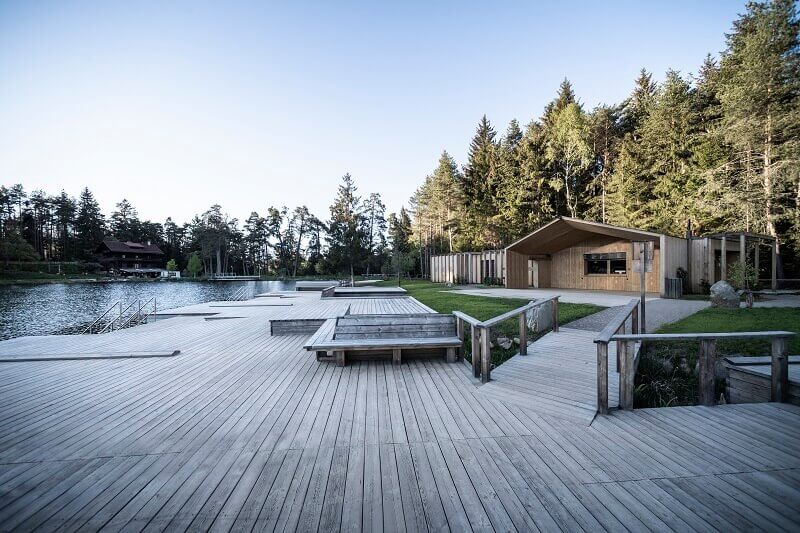It was the famed jump into the deep end: at the idyllic Völser Weiher Lake in South Tyrol, Italy, noa* network of architecture merged a modern design concept, Lake House Völs, with a well-loved tradition to deliver architecture that works in harmony with nature.

Amid a spectacular mountain backdrop lined with lush green pine forests, the Völser Weiher Lake is located over 1,000 meters above the sea level. The idyll here is palpable: a scenic nature reserve that offers year-round visitors’ space for relaxation and sports activities such as swimming or ice skating, depending on the season of the year. Architecture and design studio noa* was commissioned by the municipality of Völs to build a small, attractive swimming hut with attached public changing rooms and sanitary facilities that would complement the beautiful scenic setting of the lake, pine trees, and mountain.

This popular lake destination for outdoor excursions, particularly among the local population, whether a refreshing swim in summer or ice skating in winter, got a fresh, contemporary makeover. The new facility is designed to create space for a new chapter in which architecture combines with its surroundings in harmony.
Architecture Blending In with the Natural Surroundings
To keep the facility’s scale discreet and small to blend in with the natural surroundings, the young team of architects and designers of noa* designed two compact structures with a restrained cubature that are connected along a transverse axis. The main building of the Lake House Völs, a new snack-bar with a classic saddle roof, contains a part closed, part open kitchen and counter where food and drinks are served. It expands into an open loggia and terrace, with sweeping views over the lake and a newly designed bathing area.

The transverse axis that connects the two buildings is defined by an open recess with a wooden folding element. The recess functions as the second counter where bathers, pedestrians, and cyclists can purchase small refreshments, ice cream, and food. The recess also acts as a clever partition, so the loggia and terrace area can be kept comfortably quiet, while simultaneously enabling quick and easy self-service for guests.
Creating Places – Indoors and Outdoors in Harmony
The second building structure is a separate cube connected to the snack-bar, which is dedicated to its public function and together with the main building forms a tight ensemble both architecturally and functionally. It is here that the sanitary facilities meet accessibility requirements and provide changing rooms for enthusiastic leisure athletes such as swimmers or ice skaters.

In the facilities’ center, there is a small open atrium with changing rooms for guests and lockers specially made by local craft businesses. The atrium offers a glimpse of the skyline to signal an inviting welcome for bathers and hikers. In these public accessible premises, a robust resin trowel technology was selected that can both withstand the wear and tear of skates as well as ensure safety on a wet floor. To blend in with the natural environment, the architects’ interior design focuses on a strong visual harmonization between the indoors and outdoors.

Green was chosen as the base color for the floor, walls, and ceiling, with different tints, tones, and shades helping to create an ambiance of flowing continuation of nature.
Becoming One
The floor and vertical surfaces add another authentic design feature to the lakeside hut and recreational facility: to plant the architecture firmly within its’ location, noa* – network of architecture incorporated a traditional South Tyrolean lace pattern into the resin filler. The motifs of the traditional lace were briefly pressed into the damp resin and quickly removed to create an irregular, three-dimensional effect. These 3D patterns, sometimes more, and sometimes less readily apparent, add a special visual flair and a touch of spontaneity.

While the main building exudes a characteristic presence and is roughly equal in size to the old structure, the architects created a concept in which the other volume takes a back seat optically.

The wooden frame construction along the transverse axis, which connects the two facility buildings, also acts as a support structure for climbing plants. Within a few months, the planned fast-growing jasmine will envelop the changing rooms in natural, green foliage. When viewed from the lake, the greenery will make the building disappear into its’ surroundings.
Soak Up the Serenity in a Rendezvous with Nature
This architectural project is planted in a unique natural landscape in Italy and offers beautifully framed perspectives of views of the lake, forest, and mountain. The specially selected, untreated larch wood facade will be slowly changing as it’s exposed to the natural elements over time.

The newly built bathing jetties, made with wood from the surrounding forests, branch out and dissolve into the lake, guiding visitors from the buildings into the water. Meanwhile, the less-than-conspicuous architecture highlights the flora, giving it space to gently insert itself. Every design element of the project demonstrates noa’s* commitment to handling natural environments responsibly and with care while remaining true to their architectural standards. Between the freshly laid rows of reed and the new area for children, the contemporary design creates space for nature lovers to soak up the serenity in a rendezvous with nature.

Additional Information
Project name – Lake House Völs
Location – Fiè allo Sciliar, South Tyrol, Italy
Project Description Article – Barbara Jahn-Rösel, Marianne Lehnis
Photographs by Alex Filz

For more creative inspiration, you are welcome to follow Archi-living.com on social media.
Design Hotels – Romantic Italian Weekend – Find Out More
Eco Lodge Design Project – Kasiiya Papagayo in Costa Rica – Discover More
